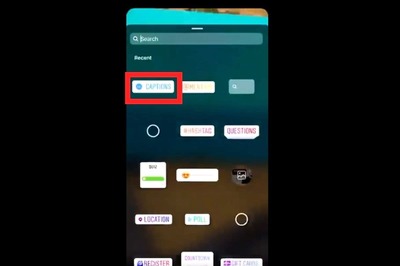
views
What are angel fangs?
Angel fangs are a pair of vertical lip piercings. Angel fans are a symmetrical piercing placed above your upper lip that exit from the bottom of the lip. They’re frequently worn with curved barbell jewelry, and the bottom pieces of the jewelry often have spiked ends to give the appearance of fangs. In general, angel fangs are placed at the fleshiest part of the lip so the piercing stays in the proper position.
Angel Fang Healing Time
Angel fangs typically take 12-16 weeks to heal. When you first get your angel fangs done, expect some swelling, redness, and pain or tenderness around the piercing site, though this should lessen after a few days. Oral piercings also frequently cause your lips to be more chapped than usual. If there are no complications, your piercing should be completely healed within 16 weeks. As you adjust to your piercing, it may also be difficult to eat for a while. Be careful not to bite down on your jewelry. Remember to follow your piercer’s instructions on how to care for your piercing as it heals. For more information, continue to the section “Caring for Your Piercing.”
Common Issues with Angel Fang Piercings
You must have a full upper lip to get angel fangs. Angel fangs and many other facial piercings are anatomy dependent, which means that a piercing can only be safely done on people who have the right features. For angel fangs, your upper lip must be full enough and have a defined ridge to support the piercing. If your lip is too thin or flat, your piercing may not heal correctly or stay in the right place. Therefore, not everyone can get angel fangs. Even if you can safely get angel fangs, they may not always sit exactly where you want them, as your piercer has to choose the position in which they’ll have the best chance of healing correctly.
They’re prone to migration. When piercings “migrate,” it means they move from their original location to a new one. This is a common issue with angel fangs because of how often you have to move your mouth to eat or talk. If your jewelry looks like it’s hanging differently, your piercing hole appears larger, or your piercing remains sore and irritated after a few days, your piercing may be migrating. If this happens, contact your piercer as soon as possible. They’ll tell you if you need to take the piercing out.
Your body may reject the piercing. Angel fangs are often subject to rejection. This means that your body has identified the piercing jewelry as a foreign object and is trying to push it out of your skin. When a piercing rejects, it will move closer to the surface and may eventually come completely out of your skin. Other signs include redness, swelling, and increased soreness around the piercing. As with migration, contact your piercer if you think your angel fangs are being rejected.
Angel fangs scar easily. If your angel fangs migrate or reject, they may leave severe scars behind. Even if you choose to take your piercings out on your own, there’s a good chance your lip will scar. These sometimes appear as bumps on the bottom of your upper lip.
Angel fangs can sometimes damage your teeth. While this isn’t always the case, angel fangs and other oral piercings may rub against your teeth and gums while you eat. This may eventually erode tooth enamel, fracture teeth, and cause gingivitis. However, if positioned correctly, angel fangs shouldn’t enter your mouth at all, meaning they shouldn’t damage your teeth.
Angel Fangs Healing & Aftercare
Follow your piercer’s aftercare instructions. When you get your piercing, your piercer should tell you what to expect as it heals and how to take care of it. Remember that they’re the professional, so follow their instructions exactly—even if you see other information online. If you have questions or feel strongly about doing something different, discuss it with your piercer so you can figure out a process that works best. If your piercer is not communicative about what to expect during and after your piercing session, they may not be reputable and it might be better to go somewhere else.
Don’t touch your piercing. Touching your piercing can cause irritation, infection, and slow down the healing process. Do not play with your jewelry or touch your piercing more than necessary. If you must touch it, only do so after you have thoroughly washed your hands with antibacterial soap and warm water.
Rinse your mouth with saline when you wake up, eat, and go to bed. As your piercing heals, it’s important to keep it clean. Rinse your mouth with saline solution or an alcohol-free mouthwash when you wake up and before you go to bed, as well as after any meals or snacks. This helps keep food particles and other debris out of the piercing so it doesn’t become irritated or infected.
Clean the outside of your piercing with saline. Whenever you rinse your mouth, remember to clean the outside of your piercing, as well. Do this by spraying it with saline or by soaking a piece of gauze in saline and gently dabbing and rinsing the jewelry. Remember to wash your hands before touching your piercing.
Practice good oral hygiene. Because your mouth can harbor a lot of bacteria, it’s extremely important to practice good hygiene while your angel fangs heal. Use a new, soft-bristled toothbrush and store it away from other toothbrushes. Brush your teeth at least twice a day and floss daily. If you use mouthwash, make sure it’s alcohol-free so it doesn’t irritate your piercing.
Stay away from spicy or acidic foods. Learning to eat with angel fangs can be difficult enough as is, but it will be even more complicated if you eat foods that irritate your oral tissue. This includes anything spicy, acidic, or crunchy. Try to eat softer foods and chew slowly and carefully to avoid unnecessary complications.
Stay hydrated while your piercing heals. Like many oral piercings, your angel fangs may cause your lips to become chapped. Using chapsticks and oils on your lips will get into your piercing and cause irritation, so avoid using them. Instead, drink plenty of water to help hydrate your lips from the inside and will help your body heal more quickly.
Don’t drink alcohol or smoke while your angel fangs heal. Alcohol (including that in mouthwash) and smoke will irritate your piercing and slow down the healing process. Smoking can even increase the risk for complications with your piercing. If possible, avoid these things entirely, but if you can’t, try to cut back as much as you can.
Avoid kissing and other sexual oral contact. Even if they practice good hygiene, other people’s mouths harbor bacteria that could cause your piercing to get infected. Because of this, avoid kissing and any other type of oral sexual contact until your piercing is healed. Similarly, don’t share food, drinks, or utensils with others.
Don’t submerge your piercing in water. Water contains bacteria that can significantly increase your risk of infection. While your piercing is healing, avoid pools, hot tubs, and large bodies of water like lakes and oceans. If possible, take showers instead of baths, and thoroughly rinse and clean your piercing with saline solution if it gets wet.
Angel Fang Jewelry
Angel fangs use curved barbell jewelry. Vertical lip piercings like angel fangs typically require curved barbell jewelry, as this is what’s perpendicular to the tissue. Straight barbells put too much pressure on the tissue and can cause migration and irritation, while hoops sit too far away from the lip and are prone to catching and snagging. Some people prefer more decorative jewelry, but remember that the larger a piece is, the more you’ll have to clean! Many people with angel fangs ultimately want spiked jewelry so their piercing actually resembles a pair of fangs. Many piercers won’t start you out with this jewelry, however, as spikes make the piercing more difficult to heal.
How to Decide if You Want Angel Fangs
Try out fake angel fangs before getting a piercing. If you like the idea of angel fangs but aren’t sure if you’re ready to commit, grab some extra ball or spike ends designed for barbell jewelry. Dab a bit of eyelash glue onto your lip where you want the piercing to go, then stick the ends on. This will give you a good idea of what real angel fangs would look like on you. Remember, however, that angel fangs are anatomy dependent, meaning they can’t be safely pierced on everyone’s body, and if you can get them, your piercer may not be able to position them exactly where you’d like them. Consult a professional piercer if you’re seriously considering angel fangs. Be aware that angel fangs can be difficult to heal, as they’re prone to rejection and migration. They can also leave large scars if you decide to take them out. Make sure you understand how to take care of them and that having them fits your lifestyle.
Getting Angel Fangs
Find a reputable piercer. When you get a piercing, you’re creating an open wound in your body. Therefore, it’s extremely important that you are pierced by a professional in a sterile environment. Look up piercing studios in your area and read the reviews. Consider calling or visiting the studio beforehand to make sure it’s clean and to ask the piercer any questions you have. While the price may vary depending on your location, getting angel fangs typically costs between $60 and $120. If the price is significantly lower than this, your piercer might not be reputable, and if it’s significantly higher, you can probably find a better deal elsewhere.
Drink water and eat a balanced meal beforehand. Whenever you get a tattoo or a piercing, it’s recommended to drink plenty of water so you stay hydrated and to eat a good meal so your blood sugar doesn’t drop. If you don’t eat or drink beforehand, you’re more likely to faint or feel dizzy during your appointment.
Follow your piercer’s instructions during the appointment. When you arrive at your appointment, your piercer should walk you through everything that will happen. They’ll also check your anatomy to make sure you can get angel fangs and pick out appropriate jewelry. Your piercer will tell you where to sit or lay down, and they’ll try to make you as comfortable as possible during the process. If your piercer isn’t communicative or makes you feel uncomfortable, you do not have to go through with the piercing. Expect a bit of pain or pressure while getting your angel fangs. If the pain becomes unbearable, however, let your piercer know. In general, your piercer will insert a piercing needle through the bottom of your upper lip to put your jewelry in.
Be respectful if your piercer cannot give you angel fangs. Many facial piercings are determined by anatomy, and not all people can get the same piercings. You need to have a lip that is full and fleshy enough to support the piercing. If you don’t, the piercer may not feel comfortable giving you angel fangs. While you may be disappointed, remember that this is for your safety. Consider talking to the piercer to see if there are any other piercings you’re interested in.
Angel Fangs vs Angel Bites
Angel bites are a pair of piercings above your upper lip. Angel bites are a pair of symmetrical, horizontal piercings positioned above your upper lip. Unlike angel fangs, which are pierced vertically, they do not exit out the bottom of your lip. The only visible parts are the two studs above your lip. Angel bites are also sometimes called reverse angel fangs.




















Comments
0 comment